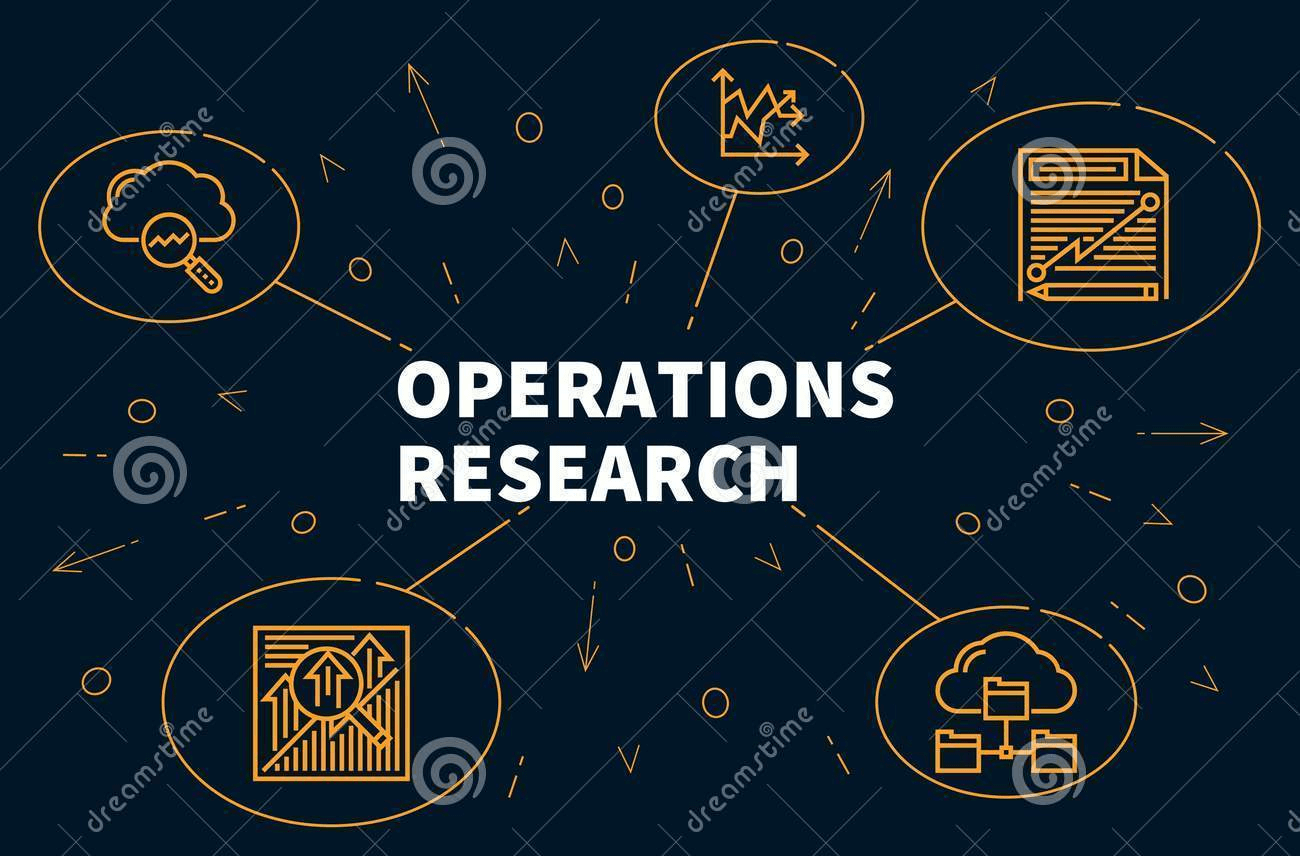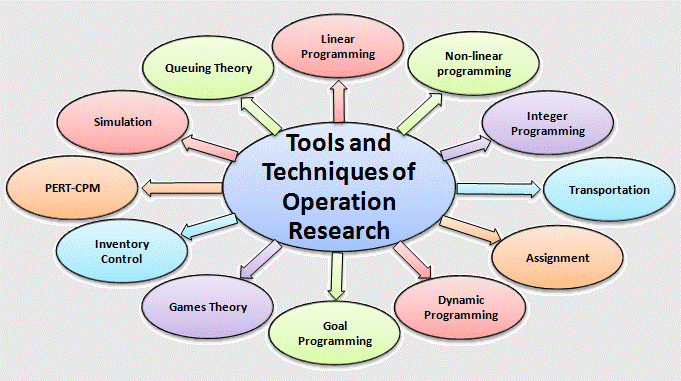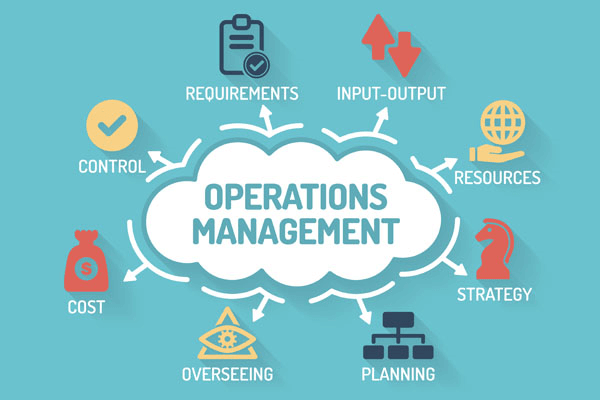Operation Research DefinitionIn any aspect of one's life, tough choices occur. When we face such a choice, we often like to think more clearly and reasonably about our possibilities and which one might be appropriate in regard to our aims. Our choices can be restricted, but we can always think closely about them and what they offer to the table in hopes of settling on which is best for us. 
Operations research is a scientific discipline that is concerned with numerical decision issues that typically involve the division and control of finite resources. Such issues occur, for example, in the activities of industrial firms, banking entities, healthcare groups, transit systems, energy and resource companies, and governments. An operations research analyst creates and utilises quantitative and statistical frameworks to help resolve judgement issues. As engineers, they are issue formulators and solvers. Their work requires the creation of a quantitative model of a structure and the study and forecast of the effects of various ways of running the system. The research may entail quantitative optimization strategies, probability and statistical techniques, tests, and computer models. Operational research instruments are not from just one field. Operations research uses techniques from different fields such as arithmetic, statistics, finance, psychiatry, engineering, etc. and combines these tools to form a new collection of information for decision-making. Currently, O.R. is a professional field that works with the employment of empirical techniques in the process of choice and especially in the allotment of finite resources. The main goal of O.R. is to offer a logical basis for choices made in the absence of complete knowledge, since systems made of humans, machines, and processes may not have clear knowledge. OR also includes having a firm grasp of the system, how it operates, and what connections arise among its constituents. This is important in seeing how limitations on one part can cause limits on others and can lower the number of options we have to take into account. For example, adding more company workers raises costs, and using more potent tools in the system will lower energy efficiency. Getting a deep knowledge of the system lets us work out where its limitations lie and which elements we value the most. By amassing a mathematical model and analysing the system's behaviour, OR professionals aim to be capable of expressing the issue as precisely as possible using math concepts. The aim is to create a mathematical issue that nearly depicts the essence of the true problem. Arithmetic issues may be far simpler to resolve because figures are not arbitrary and can almost always be improved. There are numerous ways that have been created over the years to aid in doing this, all of which are well-known and true. Occasionally, however, for highly complicated issues, these techniques cannot always identify the most effective option. For this reason, OR also means making use of other methods intended to get algorithms as close as to the best choice. Operations research may additionally be viewed as science in the sense that it involves defining, comprehending, and predicting the activity of systems, notably man-machine systems. Thereby, O.R. experts are engaged in three ancient parts of science, which are as follows:
The focus on the study of processes as a whole separates the O.R. from some of the other research and engineering fields. O.R. is a multidisciplinary field that offered answers to issues of military operations during World War II and is also effective in other programs. Today's financial apps are mainly focused on O.R. analysis for the various substitute moves. The company and industry favoured O.R. in the fields of stock, recall policies, optimal location and proportions of warehouses, advertising policies, etc. History of Operation ResearchOperations research has its roots in all previous attempts to apply science to the administration of structured systems. Nevertheless, it was A.P. Rowe, the director of the Bawdsey Research Station, who decided to try to get British scientists to instruct military officials on how to utilise the then-recently created radar to find hostile planes, which gave rise to it as a distinct field of study in 1937. The Royal Air Force officially started making attempts to expand the capacity of radar technology in 1939 in order to lengthen the duration between the initial radar alert and the hostile aircraft assault. They started by examining the actual infrastructure and communication systems, but eventually, they focused on the actions of the running staff and pertinent leaders. The studies' findings both showed methods to enhance operators' tactics and unrecognised network constraints. Radar once again served as the catalyst for identical advancements in both the British Army and the Royal Marines. Operations research is now frequently used in the army as a result of the original failure of using radar to successfully direct the discharge of antiaircraft weaponry. The renowned British chemist and eventual Nobel Prize winner P.M.S. Blackett put together a group to address the anti-aircraft issue because it was determined that the conventional method of evaluating gear did not appear to pertain to radar gun sights. Two physiologists, two mathematical theorists, an astronomer, an army commander, a retired surveyor, and later a third physiologist, a general physicist, and two mathematicians made up Blackett's Antiaircraft Command Research Group. The Navy Ordnance Laboratory hosted the very first concrete operational study work in the United States in 1942. Eventually, this team?which worked with mine warfare issues?was moved to the Naval Command, where it developed the plan for the aeroplane mining lockdown of the Japanese Inland Sea. Similar to Britain, the U.S. Air Force saw advancements sparked by radar. Most Air Force headquarters were encouraged to add operations study teams to their employees in October 1942. The Air Force had 26 such units by the conclusion of World War Two. General George Marshall recommended that all area leaders establish squads to research land and naval tactics in 1943. Many British operations research specialists went to business and politics at the conclusion of World War 2. A significant element was the nationalisation of several British businesses. The National Coal Commission created one of the initial corporate organisations. Soon after, operations research was used in the centrally organised sectors of energy and transportation. A few segments of the private industry started to do the same, especially in those sectors where there were joint research organisations, like the British Iron and Steel Research Association. For a few decades, most industrial units were also quite small due to the careful, slightly earlier growth of industrial operations research. Industrial operations research in Britain was significantly accelerated in the late 1950s, mainly due to changes in the United States. Although military research grew and organisations were extended in the United States after the war, it wasn't till the early 1950s that American businesses started to consider operations research seriously. The invention of the computer raised awareness of a variety of large-scale system issues and the possibility of fixing them, and within a decade, approximately half of the major American companies started using operations research. The business also adopted the method somewhere else. The organization of societies began with the Operational Research Group of Britain, which was founded in 1948 and later changed its name to the Operational Research Council in 1954. In 1952, the American Operations Research Association was established. There were numerous additional state organisations; the very first operations research meeting was conducted in 1957 at Oxford University. A global organisation for operational research groups was established in 1959. Operations research made its educational debut in 1948 with the introduction of a study in non-military methods at the Massachusetts Institute of Technology in Cambridge. The Cleveland-based Case College of Technology (presently Case Western Reserve University) launched a master's and PhD degree programme in 1952. Ever since numerous significant American scholastic organisations have launched programmes. At the University of Birmingham in the UK, classes first began in the early 1950s. At the recently established University of Lancaster, the first position in operations research was established in 1964. For most nations with a national operations research organisation, equivalent advancements have been made. The Operational Research Quarterly, the very first academic publication in the UK, was started in 1950; in 1978, its title was altered to Journal of the Operational Research Society. The Bulletin of the Operations Research Association of America, which was launched in 1952 and subsequently changed to Operations Research, came next. The International Summaries in Operations Research were first published in 1961 by the International Union of Operational Research Organizations. Operations research is still a relatively new scientific endeavour, regardless of its rapid development. Its strategies and tactics, as well as the fields in which they are used, are projected to keep expanding quickly. Its past has had a significant influence on the years to come. Elements of Operation Research
There are three main traits of all operations in recent studies: 1. Optimization: The goal of operations research is to obtain the best possible results under the given conditions. Optimization also includes analysing and narrowing down possible choices. When determining how to best maximise a circumstance, you may run into constraints, which are restrictions that could happen in real-world situations. For instance, the amount of time each individual is permitted to work as a result of labour regulations would be the limit for a company having hiring problems. While using operations research to resolve business problems, you may contrast various choices to more thoroughly evaluate the advantages and disadvantages of each after taking limitations into account. 2. Simulation: This entails creating models or instances so you can try out and test ideas before implementing them. In the simulation, ideas are tested on figures before being put into practise, and formulas are also used to assess the possible outcomes of a scenario. A business may change some of the restrictions or variables in the calculation while using optimization techniques to attempt to get a slight difference. By modelling an occurrence, operations research makes it easier to explain a scenario or a possible result of a scenario. 3. Probability and statistics: This involves using mathematical formulas and data to unearth valuable insights and concerns, make accurate forecasts, and try possible remedies. The goal of evolutionary algorithms, which are used in operations research, is to find a minimal or highest figure that matches a specific set of options. An organisation that seeks to completely employ a production plant, for instance, may implement a programme that takes into account the number of workers needed, their hourly wages, and the maximum amount of time each worker can work. Operation Research Techniques
Operational research techniques include: 1. Linear programmingYou undoubtedly faced mathematical equations in math courses in school, and you might have learned how to answer them using a stylus and paper. An optimization method known as linear programming uses a linear objective function to handle sets of linear restrictions. It is the operations research technique that is best recognised. 2. Theory of queues or waiting linesQueuing theory is the second area of operations research. The prior illustration may have been more apparent, but a waiting queue can also be precisely defined mathematically. Once this is completed, queuing theory enables a company to comprehend and enhance client wait times while also improving staff administration. 3. Product management programmesLogistics management is the third problem that operations research addresses. For a business, stock control is challenging and dependent on numerous choices, including those related to buying, storage, shipment, monitoring, and much more. Different methods that address all of a firm's stock duties are grouped together by inventory control systems. Economic Order Quantity (EOQ), Inventory Production Quantity (IPQ), and ABC Analysis are the three most popular methods for stock management. You ought to check into those if you want to learn more about inventory administration. 4. Network SurveyThe subject of network analysis is somewhat distinct from the things that were mentioned earlier. A programme is modelled as an optimizable tree in network analysis. Graphs made up of connections and nodes generally occur in graph theory. Every node is a spot, and every edge shows whether a particular set of nodes are connected to one another. A social networking site, where each user's identity is depicted as a node and each buddy connection as an edge, is an excellent illustration of this form of data. Methodology of Operation Research
It may be used to address issues with project planning, supply chain management, rescheduling, technology, navigation, transit, or route optimization. Using a predetermined set of stages, the operations research method entails analysing each component of a particular issue separately. These actions could involve: 1. Finding an Issue that must be addressed:No matter if, it is an internal or external issue, finding the problem that needs to be resolved is the first stage. An issue for an OR research article should indeed take into account the finances of the performance since OR is a basic research into the procedure of a man-machine association.
2. Identifying the restrictions:Once the issue has been identified, it is essential to decide what restrictions or limitations the solution must take into account. 3. Making a framework based on the issue:It is possible to create a logical mathematical model based on that particular issue that also takes into consideration the limitations after determining the factors at play. 4. Information inputted into the approach:Each new bit of relevant evidence can be incorporated into the algorithm to help generate answers. 5. Putting each probable modification to the test:After creating a collection of answers, it is advantageous to apply the framework to assess each one's effectiveness and discover which one has been most successful. 6. Placing the concept into action:Executing the answer within the company and reassessing it to be certain that it properly resolves the issue are the ultimate stages of the procedure. Benefits of Operation ResearchOperations study utilizes facts to produce evidence that corporate executives can use as findings to better outcomes and make more educated choices about the company's long-term prospects. Operations research develops workable answers to difficult business problems. Operations research has added advantages as well, such as: 1. Presents in-depth ResearchInsights, which employ quantitative and empirical techniques to analyse and solve different issues, are a foundational component of operations research. These techniques allow operations research to give decision-makers a more thorough and perceptive analysis. This enables them to provide more detailed and complete answers to issues. Additionally, it can teach them how to approach comparable issues in the future. 2. Eliminates UnpredictabilityOperations research can assist businesses in removing potential risks by utilising tried-and-true methodologies and optimization models. Adding accurate data to a model that has previously been successful in resolving issues can assist employers in lessening or even eliminating uncertainty. Possessing trustworthy data to address problems can give business executives more faith and facilitate their ability to handle intricate organisational processes. 3. Encourages Higher OutputOperation Research can contribute to improved workplace efficiency by lowering business uncertainty and enhancing interaction among different teams and divisions. Its sophisticated models can give the employees the knowledge they need to make more informed judgements, whether those judgements entail implementing new technology or entering an unfamiliar market. Additionally, it is helpful for everyday company operations like staff budgeting. Operation Research Study ExamplesBy looking at certain instances of this research, you can gain a better understanding of the methodology it employs and the strategies it can offer. Operations research can handle a range of issues that may impact companies of all kinds throughout a broad range of industries. Case studies for operation research studies are as follows: Case 1:A medical facility with a staffing deficit hires an operations research expert to ascertain the absolute necessities of staff required to keep the facility running smoothly. They conclude that the limitations must include the number of open roles, the facility's wage scale, and the handful of permits needed for particular tasks. The researcher can determine the best personnel configuration for the location by building a model with varying data constituents. Case 2:A business that manufactures chemicals realises that it is creating far too much stock, which is causing goods with a brief storage period to expire. By first evaluating the facility's output capacities and then comparing its stocking requirements to the expiration life of each item in stock, it decides to implement operations research in the scenario. In an effort to lessen wastages brought on by the expiry of expensive products, an operations research researcher calculates the ideal manufacturing timetable for goods with a shortened shelf life using such limitations. Case 3:A promotion company wants to know what kind of advertising works best with its clientele. It establishes a framework with all of its marketing choices and determines which has the best reaction and interaction ratios using operations research. The company is able to utilise this information to ascertain the kinds of advertising that consumers favour and modify its plan as necessary.
Next TopicAcids and Bases Definition
|
 For Videos Join Our Youtube Channel: Join Now
For Videos Join Our Youtube Channel: Join Now
Feedback
- Send your Feedback to [email protected]
Help Others, Please Share










